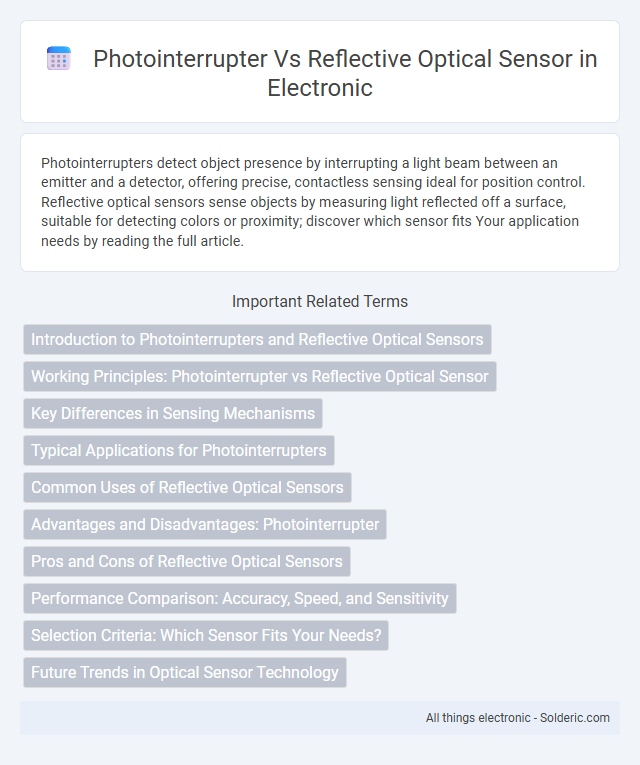Photointerrupters detect object presence by interrupting a light beam between an emitter and a detector, offering precise, contactless sensing ideal for position control. Reflective optical sensors sense objects by measuring light reflected off a surface, suitable for detecting colors or proximity; discover which sensor fits Your application needs by reading the full article.
Comparison Table
| Feature | Photointerrupter | Reflective Optical Sensor |
|---|---|---|
| Operating Principle | Interrupts a light beam between emitter and detector | Detects light reflected off a target surface |
| Sensor Type | Slot-type (transmissive) | Proximity and position sensing |
| Detection Range | Short range, typically a few millimeters | Variable, up to several centimeters depending on surface |
| Applications | Object counting, position detection, speed measurement | Surface detection, object proximity, color sensing |
| Installation | Requires precise alignment of emitter and detector | Easier installation; aligned with target surface |
| Cost | Generally lower cost | Typically higher due to complexity |
| Environmental Sensitivity | Less affected by ambient light | More susceptible to interference from ambient light |
Introduction to Photointerrupters and Reflective Optical Sensors
Photointerrupters consist of an infrared LED and phototransistor arranged facing each other, detecting object presence by interruption of the light beam. Reflective optical sensors use a single emitter and detector positioned side-by-side to measure reflected light from nearby surfaces, enabling object detection without beam interruption. Your choice between these sensors depends on application requirements like detection method, object proximity, and environmental conditions for optimal performance.
Working Principles: Photointerrupter vs Reflective Optical Sensor
Photointerrupters operate by detecting the interruption of a light beam between an emitter and a detector, making them ideal for precise object counting or position sensing in applications like rotary encoders. Reflective optical sensors rely on light emitted towards a surface and measure the intensity of the reflected light to determine the presence or distance of an object. Understanding these working principles helps optimize Your choice for specific tasks, with photointerrupters better suited for direct path detection and reflective sensors for non-contact proximity sensing.
Key Differences in Sensing Mechanisms
Photointerrupters use an object's physical presence to block a light beam between an emitter and a detector, providing precise positional detection through interruption. Reflective optical sensors emit light towards a target and measure the reflected signal intensity to detect object presence or surface characteristics without requiring physical obstruction. The key difference lies in photointerrupters detecting based on light interruption, while reflective sensors rely on reflected light intensity for sensing.
Typical Applications for Photointerrupters
Photointerrupters are commonly used in position sensing, object detection, and counting applications within printers, copiers, and assembly lines due to their precise optical detection capabilities. These sensors are ideal for detecting the presence or absence of objects in tight spaces where direct interruption of a light beam is required. Your choice of a photointerrupter ensures reliable performance in environments requiring consistent and accurate object detection.
Common Uses of Reflective Optical Sensors
Reflective optical sensors are commonly used in proximity detection, object counting, and position sensing in various industries, including automation and consumer electronics. These sensors detect objects by reflecting emitted light off a surface, making them ideal for small or irregularly shaped targets where direct alignment is challenging. Your systems benefit from their compact size and non-contact operation, enhancing reliability in tasks like paper jam detection and fluid level monitoring.
Advantages and Disadvantages: Photointerrupter
Photointerrupters offer precise object detection by using a physical slot that interrupts a light beam, providing high accuracy and reliability in position sensing applications. Their main advantage lies in immunity to ambient light interference, ensuring consistent performance in various lighting conditions, while a disadvantage includes limited detection range and potential mechanical wear on moving parts. Your choice of a photointerrupter ensures dependable switching for automation but may require careful alignment and maintenance compared to reflective optical sensors.
Pros and Cons of Reflective Optical Sensors
Reflective optical sensors offer compact design and ease of installation, making them ideal for proximity detection in limited spaces. Their sensitivity to surface color and ambient light can lead to inconsistent performance, requiring careful calibration and shielding. These sensors provide cost-effective solutions for non-contact object detection but may struggle with varying target reflectivity and environmental conditions.
Performance Comparison: Accuracy, Speed, and Sensitivity
Photointerrupters offer high accuracy and fast response times due to their direct beam interruption method, making them ideal for precise object detection in rapid motion applications. Reflective optical sensors provide greater sensitivity to surface variations and work well with wider detection angles but may experience slower response speeds and occasional signal noise from environmental factors. Your choice depends on whether accuracy and speed or versatility in sensitivity hold higher priority for your specific application needs.
Selection Criteria: Which Sensor Fits Your Needs?
Photointerrupters provide precise object detection by using an infrared beam interrupted by the target, ideal for applications requiring high accuracy and fast response times. Reflective optical sensors work by emitting light and detecting reflections from nearby objects, making them suitable for non-contact proximity sensing and surface detection. Your selection depends on factors such as detection range, target material, response time, and environmental conditions to ensure optimal sensor performance.
Future Trends in Optical Sensor Technology
Photointerrupters and reflective optical sensors are evolving rapidly with advancements in miniaturization, increased sensitivity, and integration with AI-driven signal processing. Future trends emphasize enhanced accuracy and energy efficiency, enabling Your devices to operate reliably in complex environments such as autonomous systems and smart manufacturing. The shift toward wireless connectivity and IoT compatibility will further expand the versatility of these optical sensors in various industrial and consumer applications.
photointerrupter vs reflective optical sensor Infographic

 solderic.com
solderic.com